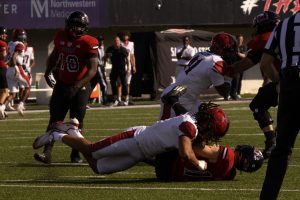NIU dealing with surge of racism
March 26, 1987
Editor’s Note: This is the third in a four-part series on discrimination. Today’s story will focus on discrimination based on race.
A student rally held March 5 brought racial discrimination against blacks, as well as other minority groups, to the attention of NIU students and faculty.
Acts of discrimination include throwing bottles at minority students from moving cars, Black Student Union President Pam Bozeman said. There are many such incidents of racial slurs and many go unreported, she said.
Bozeman said the problem of racism is starting to lead to reciprocal violence. “I don’t think they (minority students) set out to simply attack anyone. I think this is a backlash of being discriminated so long,” she said.
Gerardo Velazquez, internal coordinator for MEChA, a chicano organization, said one racial incident occurred to him while he was walking with other MEChA members and some Mexican community members. He said three male students started yelling racist comments to them.
According to Velazquez, rude comments often are yelled at different members of the organization. He said he receives several complaints of racism but none have gone to court.
George Shur, University Legal Counsel, said one case of racism currently pending in the courts involves a black faculty member who filed a complaint after being denied tenure. He said there has been only one complaint by an Asian faculty member and none by Hispanics. Shur said the university has not lost a discrimination case in the time he has worked here.
oberto Carmona, president of MEChA, said the group was denied funding from the Student Association Finance Committee. He said, “Some people at Lowden Hall don’t want to see a Mexican organization on campus.” According to Carmona, people often think Mexicans only belong on campus as dishwashers and janitors.
According to the 1985 College of Business annual report, ten of the 102 full-time professional faculty members are minorities, an increase from the nine of 92 full-time minorities employed in 1984. Included are seven Asians, two blacks and one Hispanic.
According to Velazquez, the group receives supplemental funding from the Campus Activities Board for guest speakers. However, Velazquez said the university will not help pay for a conference the organization will be having in two weeks.
Velazquez said MEChA is a student organization and does not want to be run by the university. But the university wants the group to go to the University Resources for Latinos. The Organization for Latino Students, another Mexican-oriented group is sponsored by the department.
Bozeman said racial discrimination could be helped through education such as sensitivity programs which would help minority students cope with the problems of racism they might face when starting college and to teach all students about discrimination.
Bozeman said blacks are not trying to become absorbed into the white culture because they do not want to give up their heritage, but they do want to be part of the society.
Black NIU student Yolanda McCauley said she was disowned by one of her black friends because she had too many friends who were white. She said blacks also are at fault for some of the discrimination. According to McCauley, family and peer pressure is the root of racial discrimination.
Shur said someone once pointed out to him that NIU students primarily come from white suburbs and from Chicago, one of the most segregated cities in the country. He said this could be why there are incidents of racial discrimination on campus.
Chicanos make up 85-90 percent of the “Hispanic” population on campus, Velazquez said. However, the university sponsored Hispanic Month last year and all of the events were Puerto Rican-oriented, he said. Velazquez said there are only three chicano faculty members.
Velazquez said this is one example of why the university needs to establish a center for Chicano Studies. He said there are no public universities in Illinois which have such a service, even though Illinois has the third largest Mexican-American population in the U.S.
“I don’t think they (minority students) set out to simply attack anyone. I think this is a backlash of being discriminated so long … “
Pam Bozeman, Black Student Union president






